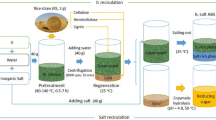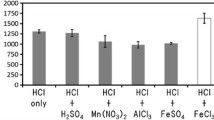Abstract
Fabricating an aqueous ionic liquid (IL) for deconstruction and dissolution of lignocellulose is attractive because addition of water could reduce the cost and viscosity of the solvent and improve the biomass processing, but the solvating power of the IL is usually depressed in the presence of water. In the present study, an aqueous IL consisting of 1-butyl-3-methylimidazolium chloride (BmimCl), water, and lithium chloride was fabricated for efficient deconstruction and dissolution of lignocellulose (bamboo). The dissolution of cell wall components (cellulose, lignin, and hemicelluloses) in the aqueous IL was investigated. The results indicated that the presence of water significantly reduced the solvating power of BmimCl; For example, 11.5 % water decreased the dissolution of bamboo in BmimCl from ~97 to ~53 %. Dissolution of cellulose and lignin was specifically depressed. However, addition of lithium chloride was able to improve the tolerance of BmimCl to water and enhance the deconstruction and dissolution of biomass in BmimCl with high water content. It was found that approximately 80 % bamboo could be dissolved in solvent consisting of 45 wt% BmimCl and 55 wt% LiCl·2H2O (25 wt% overall water content in the solvent). In particular, lignin and hemicelluloses were selectively dissolved by 96 and 92 %, respectively. The undissolved residue was predominantly composed of cellulose (~86 %) with a small amount of lignin (<5 %). BmimCl-LiCl-H2O is a promising and effective solvent system with low cost and viscosity for biomass processing.








Similar content being viewed by others
References
Agnieszka B, Michael JR, Trang QT, David JL, Richard JM, Tom W (2011) Ionic liquid pretreatment of lignocellulosic biomass with ionic liquid–water mixtures. Green Chem 13:2489–2499
Amarasekara AS, Ebede CC (2009) Zinc chloride mediated degradation of cellulose at 200 degrees C and identification of the products. Bioresour Technol 100:5301–5304
Andanson JM, Bordes E, Devemy J, Leroux F, Padua AAH, Gomes MF (2014) Understanding the role of co-solvents in the dissolution of cellulose in ionic liquids. Green Chem 16:2528–2538
Binder JB, Raines RT (2009) Simple chemical transformation of lignocellulosic biomass into furans for fuels and chemicals. J Am Chem Soc 131:1979–1985
Cammarata L, Kazarian SG, Salter PA, Welton T (2001) Molecular states of water in room temperature ionic liquids. Phys Chem Chem Phys 3:5192–5200
Carlson TR, Vispute TP, Huber GW (2008) Green gasoline by catalytic fast pyrolysis of solid biomass derived compounds. ChemSusChem 1:397–400
Cosgrove DJ (2005) Growth of the plant cell wall. Nat Rev Mol Cell Biol 6:850–861
Fu DB, Maz G (2011a) Aqueous ionic liquid pretreatment of straw. Bioresour Technol 102:7008–7011
Fu DB, Maz G (2011b) Optimization of processing conditions for the pretreatment of wheat straw using aqueous ionic liquid. Bioresour Technol 102:8003–8010
Himmel ME, Ding SY, Johnson DK, Adney WS, Nimlos MR, Brady JW, Foust TD (2007) Biomass recalcitrance: engineering plants and enzymes for biofuels production. Science 315:804–807
Huber GW, Iborra S, Corma A (2006) Synthesis of transportation fuels from biomass: chemistry, catalysts, and engineering. Chem Rev 106:4044–4098
Iiyama K, Lam T, Stone BA (1994) Covalent cross-links in the cell wall. Plant Physiol 104:315–320
Kilpeläinen I, Xie HB, King A, Granstrom M, Heikkinen S, Argyropoulos DS (2007) Dissolution of wood in ionic liquids. J Agric Food Chem 55:9142–9148
Kulkarni PS, Branco LC, Crespo JG, Afonso CA (2007) A comparative study on absorption and selectivity of organic vapors by using ionic liquids based on imidazolium, quaternary ammonium, and guanidinium cations. Chem Eur J 13:8470–8477
Lasse K, Arno P, Somdatta D, Martin L, Mikhail G, Ilkka K, Alistair WTK (2013) On the solubility of wood in non-derivatising ionic liquids. Green Chem 15:2374–2378
Liu CZ, Wang F, Stiles AR, Chen G (2012) Ionic liquids for biofuel production: opportunities and challenges. Appl Energy 92:406–414
Martin G, Tim L, Omar AES, Thomas H (2011) Tailored media for homogeneous cellulose chemistry: ionic liquid/co-solvent mixtures. Macromol Mater Eng 296:483–493
Mazza M, Catana DA, Garcia CV, Cecutti C (2009) Influence of water on the dissolution of cellulose in selected ionic liquids. Cellulose 16:207–215
O’Connor RT, DuPre EF, Mitcham D (1958) Applications of infrared absorption spectroscopy to investigations of cotton and modified cottons. Part I: physical and crystalline modifications and oxidation. Text Res J 28:382–392
Pang ZQ, Chen JC, Dong CH, Yang GH (2014) Highly selective and efficient extraction of lignin in kraft pulp by aqueous ionic liquids for enhanced bleaching properties. RSC Adv 4:29897–29900
Peter BH, Kenneth RS, Thomas W (1993) Hydrogen-bond acceptor abilities of tetrachlorometalate (II) complexes in ionic liquids. J Chem Soc Dalton Trans 17:2639–2643
Rogers RD, Seddon KR (2003) Ionic liquids–solvents of the future? Science 302:792–793
Sanghamitra S, James DM, Dimitris SA (2013) Review of cellulose non-derivatizing solvent interactions with emphasis on activity in inorganic molten salt hydrates. ACS Sustain Chem Eng 1:858–870
Sebastian F, Sasisanker P, Harvey WB, John MP (2011) Viscosities of acetate or chloride-based ionic liquids and some of their mixtures with water or other common solvents. J Chem Eng Data 56:31–34
Swatloski RP, Spear SK, Holbrey JD, Rogers RD (2002) Dissolution of cellulose with ionic liquids. J Am Chem Soc 124:4974–4975
Vo HT, Kim CS, Ahn BS, Kim HS, Lee H (2011) Study on dissolution and regeneration of poplar wood in imidazolium-based ionic liquids. J Wood Chem Technol 31:89–102
Wen JL, Yuan TQ, Sun SL, Xu F, Sun RC (2014) Understanding the chemical transformations of lignin during ionic liquid pretreatment. Green Chem 16:181–190
Xu AR, Wang JJ, Wang HY (2010) Effects of anionic structure and lithium salts addition on the dissolution of cellulose in 1-butyl-3-methylimidazolium-based ionic liquid solvent systems. Green Chem 12:268–275
Yang YJ, Shin JM, Kang TH, Kimura S, Wada M, Kim UJ (2014) Cellulose dissolution in aqueous lithium bromide solutions. Cellulose 21:1175–1181
Zhang ZC (2013) Catalytic transformation of carbohydrates and lignin in ionic liquids. WIREs Energy Environ 2:655–672
Zhao HB, Holladay JE, Brown H, Conrad Zhang ZC (2007) Metal chlorides in ionic liquid solvents convert sugars to 5-hydroxymethylfurfural. Science 316:1597–1600
Acknowledgments
The authors are grateful for financial support from the National Science Foundation of China (31370580), Special Fund of Taishan Scholar Project, Natural Science Foundation of Shandong Province (ZR2015CM006), and Talented Scientist Funding of Shandong Province (BS2013HZ020) to Z.P. and for NSF (CBET 1159561) and WARF Accelerator grants to X.P.
Author information
Authors and Affiliations
Corresponding author
Rights and permissions
About this article
Cite this article
Pang, Z., Dong, C. & Pan, X. Enhanced deconstruction and dissolution of lignocellulosic biomass in ionic liquid at high water content by lithium chloride. Cellulose 23, 323–338 (2016). https://doi.org/10.1007/s10570-015-0832-7
Received:
Accepted:
Published:
Issue Date:
DOI: https://doi.org/10.1007/s10570-015-0832-7




